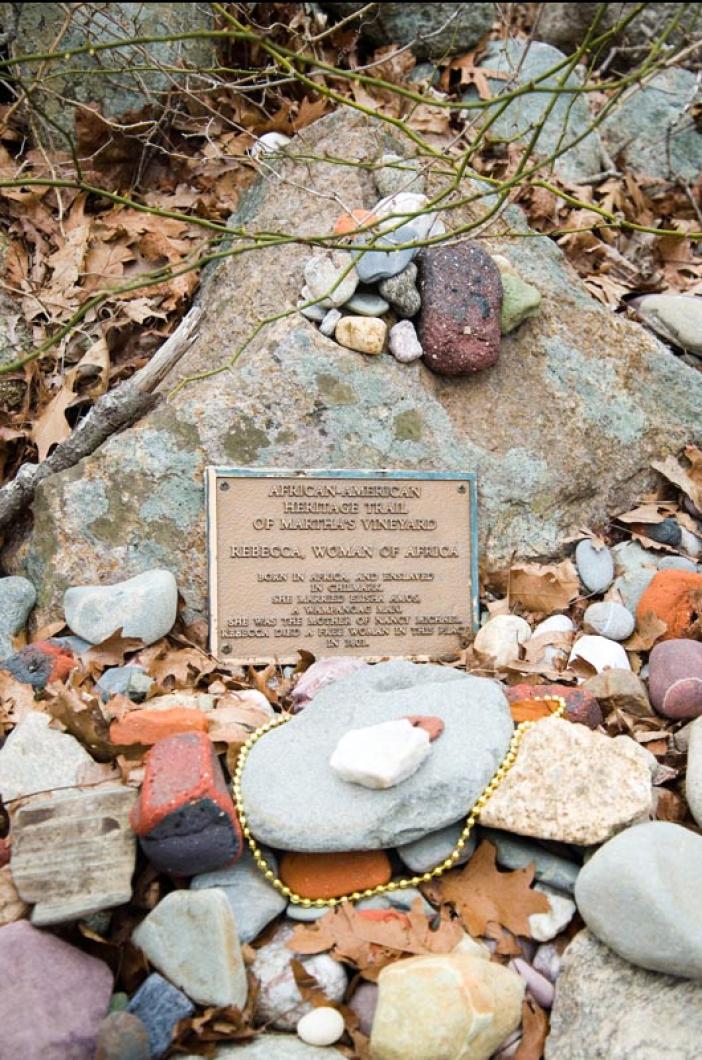In the Waterview Farm area of Oak Bluffs is a boulder as tall as a man. Back in the 1790s, the Rev. John Saunders delivered his sermons here, from atop “Pulpit Rock.” Mr. Saunders, who was African-American, was one of the first people to preach Methodism on Martha’s Vineyard.
But for anyone who doesn’t know the story, this is just a rock in an Oak Bluffs subdiyision. In fact, many sites, though significant to the Vineyard’s African-American history, sit unmarked.
Today, some Island people want to change that.
Elaine Weintraub, a high school teacher, and Carrie Tankard, vice president of the Vineyard chapter of the NAACP, have proposed a series of historic markers for these sites. They would also like to publish a map high, lighting the sites and explaining their significance. This African-American cultural history trail, as they call it, would be educational for both Island people and visitors.
“When people come to Martha’s Vineyard, what are they going to see?” said Mrs. Weintraub. “They’re going to see these beautiful old houses. They’re going to see the Flying Horses. They’re going to see a typical fishing community that evolved into a summer resort. Maybe they’ll go to Gay Head and see the Wampanoag tribal council. But what will they see of the African-American contributions until we have this trail? I think to the casual visitor as much as for the people who are already here, we need to have the African-American experience included.”
Mrs. Weintraub and Mrs. Tankard met because of their common interest in this topic. Mrs. Tankard offered guidance and information to Mrs.-Weintraub, whose extensive research has culminated in the book, What the History Books Don’t Tell Us: Aspects of the African-American Experience in Massachusetts with Particular Reference to the Island of Martha’s Vineyard. The two began discussing a heritage trail after they heard about one on Nantucket.
So far, Mrs. Weintraub and Mrs. Tankard have collected $1,200 to establish the trail. They don’t have a fund-raising goal yet, but Mrs. Tankard said the first order of business will be to publish a map or brochure explaining the sites. Then they will pursue funding for markers.
“You have to create some sort of track record, some sort of interest.” Mrs. Tankard said. “Then you can apply for more money. This could be another tourist attraction for people.”
Among those attractions is the Chappaquiddick home of Capt. William A. — Martin, the prominent whaling captain. Captain Martin was just two generations removed from slavery his grandmother, Nancy Michaels, had been enslaved in Tisbury. His great grandmother, known only as Rebecca, was enslaved in Chilmark. Rebecca had been imprisoned and brought from West Africa.
The map would also show the inn founded by Charles Shearer. When Mr. Shearer, a former slave, came to the Vineyard with his wife Henrietta, he found a community that had no hotels serving black guests. So in 1919, he opened the Shearer Cottage, an inn that would eventually host such notable guests as Adam Clayton Powell Jr. and Martin Luther King Jr. The inn, in the Highlands area of Oak Bluffs, is still open for business today, operated by members of the Shearer family.
Many of the landmarks are linked to slavery. The Island, a port for many trade ships in the 1600s and 1700s, was also a temporary stopping point for south-bound ships carrying African prisoners. Some Island families had African slaves, even after Massachusetts banned slavery in 1788. Mrs. Weintraub would like to show the part of Chilmark, near the Great Pond, where the African woman called Rebecca was a slave.
Still, Mrs. Weintraub wants the trail to emphasize people, not just slavery.
“Slavery isn’t black history,” she said. “When you talk about slavery, you’re talking about an institution. You’re not talking about people.”
One aspect of Island history is the relationship between Native Americans and African-Americans. The Gay Head Wampanoags were known for providing refuge for African-Americans.
Randall Burton, an escaped slave, was one such beneficiary. Mr. Burton, an escaped slave, had stowed away on a boat that traveled from Mississippi to Hart Haven. From there he traveled to Gay Head, where he hid in the cranberry bogs. The sheriff found Mr. Burton in Gay Head but became transfixed and unable to arrest him, “unable to carry out the work of the devil,” according to the Sept. 29, 1854 edition of the Vineyard Gazette.
Mr. Burton sailed to Menemsha, and from there to New Bedford. Eventually, he escaped to Canada. Some historians say the Wampanoags guided Mr. Burton; others say an Island abolitionist group took charge. “It could even have been a combination of both of those,” Mrs. Weintraub said.
Whatever happened, the story is important, Mrs. Weintraub said.
“Because I teach history and I write history and my life is dealing with history, I think we need to know all of it and not just a little part. We need everyone’s story, everyone’s point of view, the hidden parts. If we only hear one side of the story, I think we all lose out.”











Comments